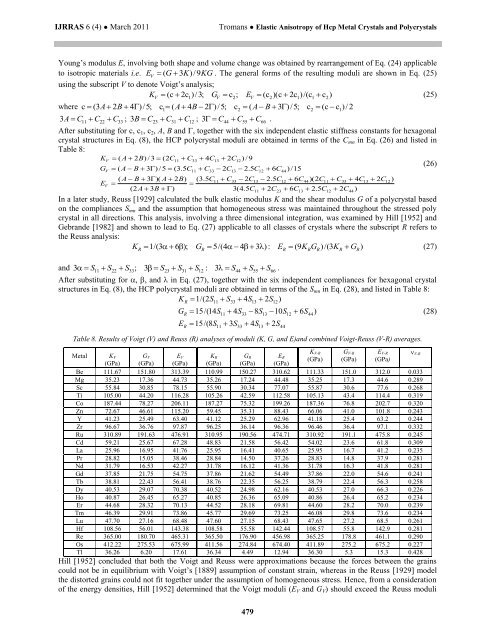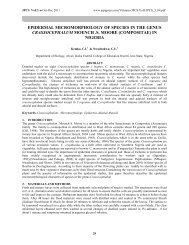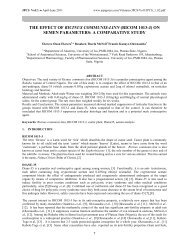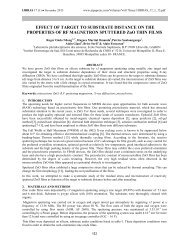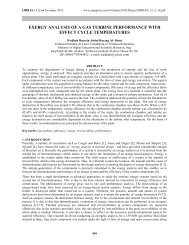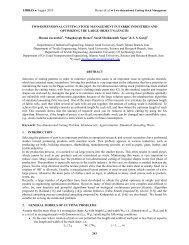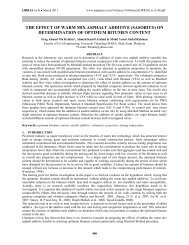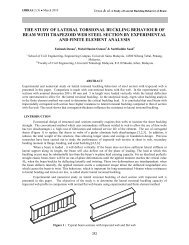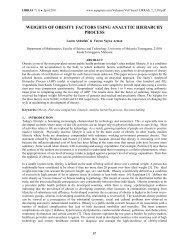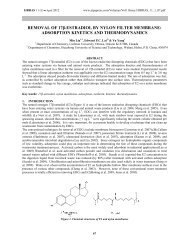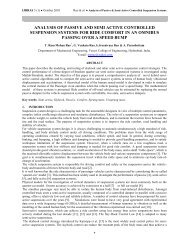elastic anisotropy of hcp metal crystals and polycrystals
elastic anisotropy of hcp metal crystals and polycrystals
elastic anisotropy of hcp metal crystals and polycrystals
Create successful ePaper yourself
Turn your PDF publications into a flip-book with our unique Google optimized e-Paper software.
IJRRAS 6 (4) ● March 2011 Tromans ● Elastic Anisotropy <strong>of</strong> Hcp Metal Crystals <strong>and</strong> Poly<strong>crystals</strong><br />
Young’s modulus E, involving both shape <strong>and</strong> volume change was obtained by rearrangement <strong>of</strong> Eq. (24) applicable<br />
to isotropic materials i.e. EV ( G 3K)<br />
/ 9KG<br />
. The general forms <strong>of</strong> the resulting moduli are shown in Eq. (25)<br />
using the subscript V to denote Voigt’s analysis;<br />
K c 2c<br />
) / 3;<br />
G c ; E ( c )( c 2c<br />
) /( c c )<br />
(25)<br />
V ( 1 V 2 V 2 1 1 2<br />
where ( 3A<br />
2B<br />
4)<br />
/ 5;<br />
c ( A<br />
4B<br />
2)<br />
/ 5;<br />
c ( A<br />
B 3)<br />
/ 5;<br />
c ( c c ) / 2<br />
c 1<br />
2<br />
2 1<br />
C11<br />
C22<br />
33 ; 3B C23<br />
C31<br />
C12<br />
; 3 C44 C55<br />
C66<br />
.<br />
3A C<br />
After substituting for c, c1, c2, A, B <strong>and</strong> , together with the six independent <strong>elastic</strong> stiffness constants for hexagonal<br />
crystal structures in Eq. (8), the HCP polycrystal moduli are obtained in terms <strong>of</strong> the Cmn in Eq. (26) <strong>and</strong> listed in<br />
Table 8:<br />
K<br />
G<br />
V<br />
V<br />
( A 2B)<br />
/ 3 ( 2C<br />
C<br />
4C<br />
( A B 3)<br />
/ 5 ( 3.<br />
5C<br />
C<br />
11<br />
33<br />
11<br />
33<br />
13<br />
2C<br />
2C<br />
13<br />
12<br />
) / 9<br />
2.<br />
5C<br />
( A B 3)(<br />
A 2B)<br />
( 3.<br />
5C11<br />
C33<br />
2C13<br />
2.<br />
5C12<br />
6C44)(<br />
2C11<br />
C33<br />
4C13<br />
2C12)<br />
EV<br />
<br />
<br />
( 2A<br />
3B<br />
)<br />
3(<br />
4.<br />
5C11<br />
2C23<br />
6C13<br />
2.<br />
5C12<br />
2C44)<br />
In a later study, Reuss [1929] calculated the bulk <strong>elastic</strong> modulus K <strong>and</strong> the shear modulus G <strong>of</strong> a polycrystal based<br />
on the compliances Smn <strong>and</strong> the assumption that homogeneous stress was maintained throughout the stressed poly<br />
crystal in all directions. This analysis, involving a three dimensional integration, was examined by Hill [1952] <strong>and</strong><br />
Gebr<strong>and</strong>e [1982] <strong>and</strong> shown to lead to Eq. (27) applicable to all classes <strong>of</strong> <strong>crystals</strong> where the subscript R refers to<br />
the Reuss analysis:<br />
KR 1/( 3<br />
6);<br />
GR<br />
5/(<br />
4<br />
4<br />
3)<br />
: ER<br />
( 9KRGR<br />
) /( 3KR<br />
GR)<br />
(27)<br />
479<br />
12<br />
6C<br />
<strong>and</strong> 3 S11 S22<br />
S33;<br />
3<br />
S23<br />
S31<br />
S12<br />
: 3<br />
S44<br />
S55<br />
S66<br />
.<br />
After substituting for , , <strong>and</strong> in Eq. (27), together with the six independent compliances for hexagonal crystal<br />
structures in Eq. (8), the HCP polycrystal moduli are obtained in terms <strong>of</strong> the Smn in Eq. (28), <strong>and</strong> listed in Table 8:<br />
K 1/(<br />
2S<br />
S 4S<br />
2S<br />
)<br />
G<br />
E<br />
R<br />
R<br />
R<br />
11<br />
15/(<br />
14S<br />
15/(<br />
8S<br />
11<br />
11<br />
33<br />
4S<br />
3S<br />
33<br />
33<br />
13<br />
8S<br />
4S<br />
13<br />
13<br />
12<br />
2S<br />
44<br />
10S<br />
44<br />
) / 15<br />
12<br />
6S<br />
Table 8. Results <strong>of</strong> Voigt (V) <strong>and</strong> Reuss (R) analyses <strong>of</strong> moduli (K, G, <strong>and</strong> E)<strong>and</strong> combined Voigt-Reuss (V-R) averages.<br />
Metal<br />
KV<br />
(GPa)<br />
GV<br />
(GPa)<br />
EV<br />
(GPa)<br />
KR<br />
(GPa)<br />
GR<br />
(GPa)<br />
Be 111.67 151.80 313.39 110.99 150.27 310.62 111.33 151.0 312.0 0.033<br />
Mg 35.23 17.36 44.73 35.26 17.24 44.48 35.25 17.3 44.6 0.289<br />
Sc 55.84 30.85 78.15 55.90 30.34 77.07 55.87 30.6 77.6 0.268<br />
Ti 105.00 44.20 116.28 105.26 42.59 112.58 105.13 43.4 114.4 0.319<br />
Co 187.44 78.27 206.11 187.27 75.32 199.26 187.36 76.8 202.7 0.320<br />
Zn 72.67 46.61 115.20 59.45 35.31 88.43 66.06 41.0 101.8 0.243<br />
Y 41.23 25.49 63.40 41.12 25.29 62.96 41.18 25.4 63.2 0.244<br />
Zr 96.67 36.76 97.87 96.25 36.14 96.36 96.46 36.4 97.1 0.332<br />
Ru 310.89 191.63 476.91 310.95 190.56 474.71 310.92 191.1 475.8 0.245<br />
Cd 59.21 25.67 67.28 48.83 21.58 56.42 54.02 23.6 61.8 0.309<br />
La 25.96 16.95 41.76 25.95 16.41 40.65 25.95 16.7 41.2 0.235<br />
Pr 28.82 15.05 38.46 28.84 14.50 37.26 28.83 14.8 37.9 0.281<br />
Nd 31.79 16.53 42.27 31.78 16.12 41.36 31.78 16.3 41.8 0.281<br />
Gd 37.85 21.75 54.75 37.86 21.62 54.49 37.86 22.0 54.6 0.241<br />
Tb 38.81 22.43 56.41 38.76 22.35 56.25 38.79 22.4 56.3 0.258<br />
Dy 40.53 29.07 70.38 40.52 24.98 62.16 40.53 27.0 66.3 0.226<br />
Ho 40.87 26.45 65.27 40.85 26.36 65.09 40.86 26.4 65.2 0.234<br />
Er 44.68 28.32 70.13 44.52 28.18 69.81 44.60 28.2 70.0 0.239<br />
Tm 46.39 29.91 73.86 45.77 29.69 73.25 46.08 29.8 73.6 0.234<br />
Lu 47.70 27.16 68.48 47.60 27.15 68.43 47.65 27.2 68.5 0.261<br />
Hf 108.56 56.01 143.38 108.58 55.58 142.44 108.57 55.8 142.9 0.281<br />
Re 365.00 180.70 465.31 365.50 176.90 456.98 365.25 178.8 461.1 0.290<br />
Os 412.22 275.53 675.99 411.56 274.84 674.40 411.89 275.2 675.2 0.227<br />
Tl 36.26 6.20 17.61 36.34 4.49 12.94 36.30 5.3 15.3 0.428<br />
Hill [1952] concluded that both the Voigt <strong>and</strong> Reuss were approximations because the forces between the grains<br />
could not be in equilibrium with Voigt’s [1889] assumption <strong>of</strong> constant strain, whereas in the Reuss [1929] model<br />
the distorted grains could not fit together under the assumption <strong>of</strong> homogeneous stress. Hence, from a consideration<br />
<strong>of</strong> the energy densities, Hill [1952] determined that the Voigt moduli (EV <strong>and</strong> GV) should exceed the Reuss moduli<br />
ER<br />
(GPa)<br />
44<br />
)<br />
KV-R<br />
(GPa)<br />
GV-R<br />
(GPa)<br />
EV-R<br />
(GPa)<br />
V-R<br />
(26)<br />
(28)


